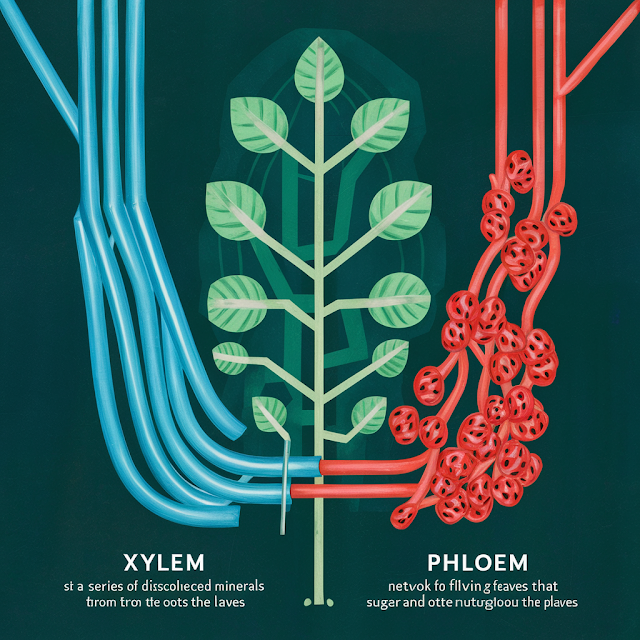What Are The Difference Between The Transport Of Materials In Xylem And Phloem With Example ?
The xylem and phloem are two types of vascular tissues found in plants, responsible for the transportation of water, nutrients, and other substances throughout the plant body.
Here are the main differences between the transport of materials in xylem and phloem:
1. Function:
Xylem: The primary function of xylem is to transport water and minerals from the roots to the rest of the plant, including the leaves. It also provides structural support to the plant.
Phloem: Phloem primarily transports organic nutrients, such as sugars, amino acids, and hormones, produced in the leaves (source) to various parts of the plant, including the roots, stems, and growing tissues (sink).
2. Direction of Transport:
Xylem: Transport is mainly unidirectional, moving water and minerals upwards from the roots towards the leaves through a process called transpiration.
Phloem: Transport can be bidirectional, moving nutrients both upwards (source to sink) and downwards (from storage organs to other parts of the plant).
3. Composition of Contents:
Xylem: The main contents transported in xylem sap are water and inorganic ions such as potassium and nitrate.
Phloem: The main contents transported in phloem sap are organic compounds such as sucrose, amino acids, and hormones.
4. Transport Mechanisms:
Xylem: Transport in xylem occurs through the process of transpiration-cohesion-tension mechanism. Water is pulled upwards due to transpiration (evaporation of water from the leaves), creating a negative pressure gradient that draws water and dissolved minerals from the roots.
Phloem: Transport in phloem occurs through a process called translocation. This process involves active loading of organic compounds into the phloem cells at the source (usually the leaves), followed by passive flow along a pressure gradient to the sink (where nutrients are needed).
Example:
Consider a tree in the springtime when it is actively growing and producing new leaves. During this period, the xylem transports water and minerals from the roots to the leaves, where they are used for photosynthesis and other metabolic processes. Meanwhile, the phloem transports the sugars produced during photosynthesis in the leaves to other parts of the plant, such as the roots and developing buds, where they are utilized for growth and energy. This demonstrates the complementary roles of xylem and phloem in the transport of materials within a plant.
Here are some additional points of comparison between xylem and phloem:
5. Cell Types:
Xylem: Xylem tissue consists of tracheids and vessel elements, along with fibers and parenchyma cells. Tracheids and vessel elements are elongated cells with secondary cell walls, specialized for water transport.
Phloem: Phloem tissue comprises sieve tube elements, companion cells, fibers, and parenchyma cells. Sieve tube elements are specialized for transporting sugars and other organic compounds.
6. Structural Characteristics:
Xylem: Xylem vessels are dead at maturity and have lignified cell walls, providing structural support to the plant.
Phloem: Sieve tube elements are alive at maturity and lack lignified cell walls, allowing for flexibility and continued transport.
7. Direction of Flow:
Xylem: Flow in xylem is predominantly driven by physical forces like transpiration and capillary action, moving from areas of high water potential (roots) to areas of low water potential (leaves).
Phloem: Flow in phloem is driven by pressure gradients established by active transport of sugars into sieve tube elements at source sites and subsequent osmotic pressure differences along the phloem pathway.
8. Response to Environmental Factors:
Xylem: Xylem flow is influenced by environmental factors such as humidity, temperature, and soil moisture. Changes in these factors can affect transpiration rates and thus water uptake by the plant.
Phloem: Phloem flow can be influenced by factors like light intensity, temperature, and hormonal signals. For instance, increased light intensity can enhance sugar production in leaves, leading to increased phloem transport to other plant parts.
9. Role in Plant Physiology:
Xylem: Besides water and mineral transport, xylem also plays a role in temperature regulation, as water movement through the plant can have a cooling effect.
Phloem: Phloem is crucial for distributing energy-rich compounds like sugars to support various plant functions, including growth, reproduction, and defense mechanisms.
10. Disease and Pests:
Xylem: Diseases or pests that affect xylem can disrupt water transport, leading to wilting and nutrient deficiency symptoms.
Phloem: Diseases or pests that affect phloem can disrupt nutrient transport, leading to stunted growth, chlorosis (yellowing), or even death of affected plant parts.
Example:
In a deciduous tree during autumn, as the days shorten and temperatures drop, photosynthesis decreases, resulting in reduced sugar production in the leaves. The phloem responds to this by reducing the flow of sugars from the leaves to other parts of the tree. At the same time, the xylem continues to transport water from the soil to the leaves until the onset of freezing temperatures, which triggers leaf abscission (shedding) and dormancy. This example illustrates the coordinated responses of xylem and phloem to seasonal changes in environmental conditions.


Post a Comment